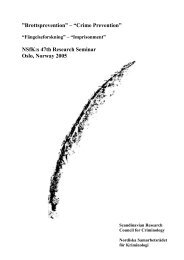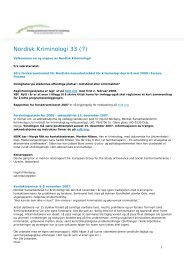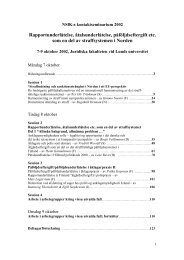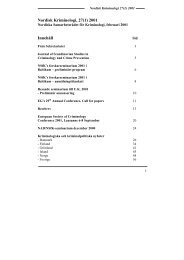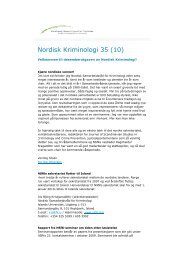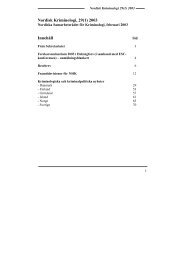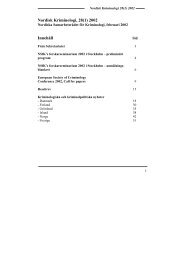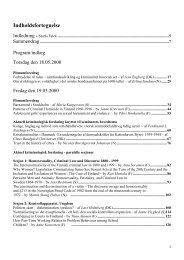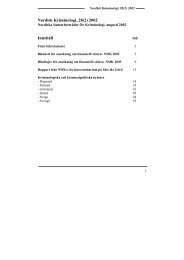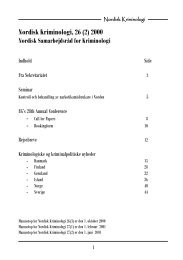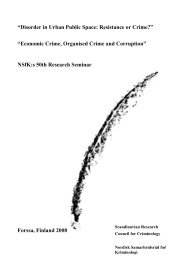Organised Crime & Crime Prevention - what works? - Scandinavian ...
Organised Crime & Crime Prevention - what works? - Scandinavian ...
Organised Crime & Crime Prevention - what works? - Scandinavian ...
Create successful ePaper yourself
Turn your PDF publications into a flip-book with our unique Google optimized e-Paper software.
NSfK´s 40. forskerseminar, Espoo, Finland 1998<br />
Karsten Ive, Head of Secretariat<br />
<strong>Crime</strong> <strong>Prevention</strong> Council<br />
Odensegade 5, 2. Sal, DK-2100 Copenhagen Ø<br />
<strong>Crime</strong> <strong>Prevention</strong> in Denmark<br />
In 1971 it was decided to establish the <strong>Crime</strong> <strong>Prevention</strong> Council (Det Kriminalpræventive<br />
Råd) with the task of working within the frames of existing legislatures, for the prevention of<br />
crime. The background for establishing the council was a drastic rise in crime up through the<br />
1960s. At the same time a reform of the decentralised structures in the administration took<br />
place, in result of which several small municipalities were put together into large municipal<br />
units. Consequently there was a loss of social control, and an increased need to develop<br />
advice regarding method and co-ordination of crime prevention.<br />
Right from the beginning it was agreed that crime prevention should be based on broad social<br />
insight, knowledge and practical experience. For this reason the Council was structured as an<br />
assembly consisting of a number of nationwide private organisations and societies and public<br />
units of administration, which together constitute the Council´s highest authority “The<br />
Plenum”. Today more than 40 organisations and units of administration have a seat in the<br />
Council. An executive committee, at present 8 people, appointed by “The Plenum” makes<br />
ongoing decisions about general and principle questions, and about financial matters.<br />
The member organisations have appointed representatives who take part in specialised<br />
working groups, at present 5, which each concern themselves with strategic subjects within<br />
crime prevention:<br />
− The technical Security measures Committee, which <strong>works</strong> with advice as regards technical<br />
protection against crime.<br />
− The Strategy Committee, whose task it is to develop broad counselling to the citizens<br />
concerning behaviour and routines that can reduce the risk of falling victim to crime.<br />
− The <strong>Crime</strong> <strong>Prevention</strong> Information Committee, which is concerned with the role of crime<br />
prevetions in schools, institutions and clubs.<br />
− The Committee for <strong>Crime</strong> <strong>Prevention</strong> in Local Planning, which concerns itself with town<br />
and housing related strategies for well-being, sense of security and joint responsibility as<br />
crime prevention factors.<br />
− The SSP Committee (The committee for co-operation between Schools, Social services<br />
and the Police), whose task it is to develop patterns for the organisation of crime<br />
prevention in the municipalities and local communities.<br />
Once anually the committees hold a debate on a specific theme, as a result of which the<br />
executive committee together with the chairmen of the 5 specialist committees lay down the<br />
fundamental work themes for the Council´s work. The themes pointed out express fields with<br />
a special public need for crime penvention development.<br />
The Council’s work is co-ordinated by a secretariat put at its disposal by the National<br />
Commissioner of the Police. The staff has legal, police, social and educational training.<br />
Moreover, a nationwide network of contact persons has been built up in the secretariat. This<br />
213



